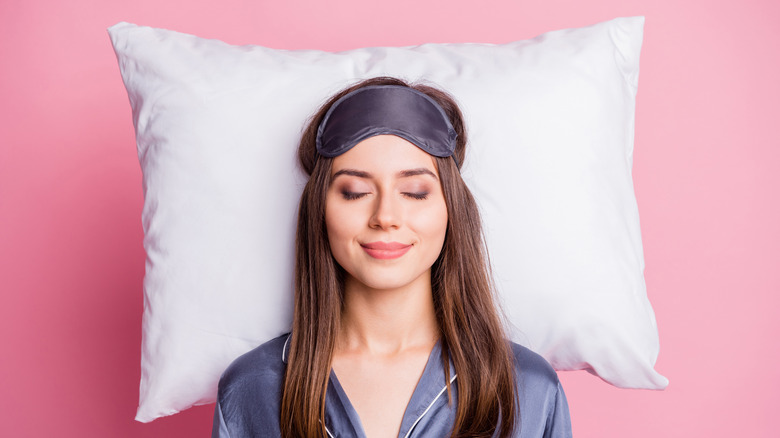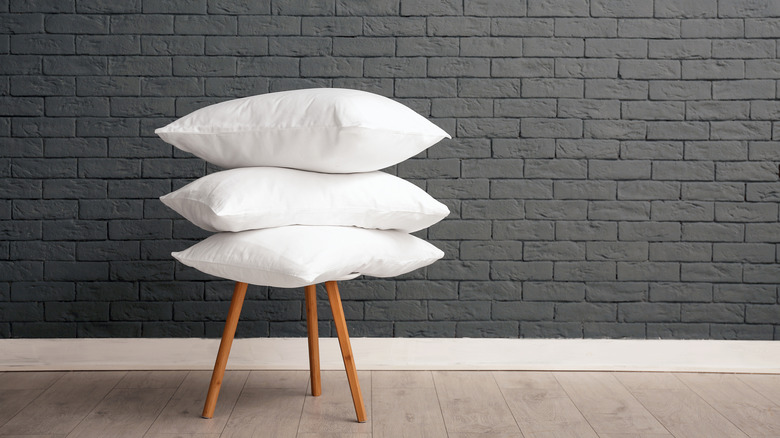Pillows: Everything You Need To Know Before You Buy
Since we spend a third of our lives sleeping, we may as well be comfortable while we do it. The pillow you use can have a major impact on the quality of your sleep. Registered nurse and clinical sleep educator Terry Cralle told Wirecutter, "If you're not sleeping as well as you should, changing pillows might be that first step." When pillows are worn out, they don't perform as well, so they should be replaced every two years or whenever they're no longer comfortable. Some people may also be using the wrong type of pillow for their sleep position. Dr. Neel Anand, professor of orthopedic surgery and director of spine trauma at Cedars-Sinai Spine Center in Los Angeles, told Forbes, "keep the proper alignment of your neck and back as a priority in your decision-making, and you'll have a much better chance of a good night's sleep."
While there is no one pillow that will work for everybody, there are still some important things to learn before making a purchase. We'll break down what to look for when shopping for the best pillows for your bedroom and discuss the key considerations to keep in mind as you shop. Read on for tips, tricks, and advice for choosing the right pillows for you.
What should you look for in a pillow?
A pillow's primary role is to provide support and stability for your neck and head while you're sleeping. Micheal Breus, Ph.D. and fellow of the American Academy of Sleep Medicine, who also goes by "the Sleep Doctor," told Popular Mechanics, "Like your mattress, your pillow is an investment in high-quality sleep, which pays dividends across your waking life."
Breus explains that "the thickness or thinness of your pillow should enable you to sleep with your head, neck, and shoulders aligned with your spine, as well as provide you comfort." Dr. Niamish Baxi, an expert in spine care and musculoskeletal medicine at the Hospital for Special Surgery in New York, told Good Housekeeping that "it's important that your neck stays 'neutral.' He further explains, "It should not be flexed forward, extended back, or rotated. Being in these positions will put a strain on the joints in your cervical spine as well as the muscles surrounding it." According to Baxi, while you're sleeping, "Your ears should be aligned with your shoulders and your chin faced forward." This means that body type should be factored in when choosing a pillow, with smaller people opting for a thinner pillow and larger people choosing thicker models.
Dr. Darren Pollack, who works as a chiropractor and medical director at DASHA Wellness & Spa, said that he can tell when a patient is using a pillow that's worn out, "Patients come to me in pain, and I know their pillow isn't keeping their neck aligned with their spine." He explains that "Over time, this wear-and-tear can cause muscle stiffness, tendonitis, nerve pain, herniated discs, and more."
Comparing the different pillow fill materials
One of the primary considerations to keep in mind while shopping for a pillow is the fill material. According to The Spruce, however, there's no single fill material that's right for everyone.
Down is one of the highest-quality materials used to fill pillows. It's derived from the soft undercoat of geese and ducks and makes for a natural filling that's fluffy and provides a high loft. The main reason to avoid down, however, is that some people have allergies to the material, and it can harbor dust mites. Nectar mentions that down can also absorb excess heat, causing discomfort for hot sleepers. Feather pillows perform similarly and tend to be more affordable. The downside of a feather filling is that it may need to be fluffed up frequently to maintain a comfortable shape.
Polyester is one of the most popular materials used to fill pillows because it's affordable and readily available. Pillows filled with polyester may also be referred to as polyfill pillows. While they are available at low prices, polyester loses its shape quickly, meaning that this style of pillow needs to be replaced frequently. One benefit, however, is that polyester is a synthetic material, so it's suitable for allergy sufferers. It's also machine-washable, making cleaning a breeze. Down alternative pillows are typically made using polyester but are designed to mimic the feel of down. Pillows filled with cotton are similarly affordable and hypoallergenic.
Memory foam pillows mold to the shape of the user's body, providing high levels of support and stability. Because of that, they're suitable for people users with any sleep position. Memory foam is, however, known for trapping heat, so memory foam pillows may not be ideal for people who live in warm climates or hot sleepers.
Which pillow is best for your sleep position?
The biggest factor determining which type of pillow will be best for you is your sleep position. Before choosing a pillow, consider which sleep position you most often find yourself in.
According to Sleepopolis, back sleepers need a pillow with medium loft and medium firmness. Back sleepers using high loft pillows may experience neck pain because it will cause their heads to be elevated. Since they put a lot of pressure on their pillows, materials that conform to the shape of the body — like memory foam — are ideal.
On the other hand, side sleepers need even higher levels of support and tend to be most comfortable with a firm pillow with a high loft. These factors ensure their spines are neutrally aligned while they sleep. Firm pillows may take some getting used to, so side sleepers may benefit from trying out a pillow with adjustable filling.
Stomach sleepers put high amounts of strain on their necks and backs, so much so that many sleep experts advise against stomach sleeping in general. Physical therapist Dr. Keith Poorbaugh says, "to mitigate the risk of stomach sleeping for articular pain in the shoulder or spine, the best option is to utilize proper pillow support." They should use a pillow with a low loft and soft support.
Dr. Breus said, "If you have neck pain and sleep on your back, look for a pillow that provides additional support while maintaining the softness that's comfortable for you."
The National Sleep Foundation reported that side sleeping is the most popular sleep position. In fact, only eight percent of people sleep on their backs and seven on their stomachs, making the vast majority of the population side sleepers. So if you're buying pillows for a guest room or rental unit, it's safest to choose products what that fact in mind.
How much do pillows cost?
Pillow prices vary widely, and their cost is largely dependent on the material used to fill them. Shoppers can spend anywhere from $10 to over $250 on a single pillow. Dr. Anand explains that price isn't always a direct indicator of quality, however, saying, "Don't assume the more money you spend, the more comfortable you'll be," adding that the best pillow is "the one that feels best to you."
Bedding Planet estimates that down-filled pillows sell for between $15 and $260 per pillow, with the price varying based on the quality of the materials and construction. Feather pillows, which are similarly made from a natural material, have a narrower price range, typically falling between $25 and $50 per pillow. Polyester, down alternative, and microfiber pillows are considerably cheaper on average and can be found for as low as $10 per pillow or as high as $85 per pillow for top-of-the-line products. Memory foam pillows have the highest starting price at $50 and can cost as much as $150.
How do you know when it's time to replace a pillow? There's one trick that several experts recommend that's known as the "book test," which works with standard fiberfill pillows. Fold the pillow in half and put a heavy book on top of it. When removing the book, the pillow should spring back into its regular shape. If it remains folded, however, it's a sure sign that it's time to start pillow shopping.




